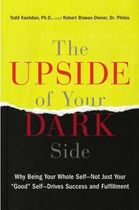Authors: Todd Kashdan and Robert Biswas-Diener
ISBN: 9781594631733
APA Style Citation
Kashdan, Todd and Biswas-Diener, Robert (2014). The Upside of Your Dark Side: Why Being Your Whole Self – Not Just Your “Good” Self – Drives Success and Fulfillment. New York: Penguin Random House LLC.
Buy This Book
https://www.amazon.com/Upside-Your-Dark-Side-Self_Drives/dp/1491528222
| upside_of_darkside_activity.pdf |
Positive psychology began in 1998 with Martin Seligman’s American Psychological Association Presidential address in which he proposed a refocusing of psychology away from illness and dysfunction and onto positive human traits and strengths such as optimism, social responsibility, compassion, courage, and gratitude. Positive psychology proponents Kashdan and Diener propose in The Upside of Your Darkside that psychology and mental health depend on balance and that negative emotions have an important and useful purpose. The authors argue that although mindfulness, compassion, happiness and other positive emotions are keys to a productive and purposeful life, negative emotions despite how uncomfortable they may be are important tools for success and fulfillment. Kashdan and Diener are unique among positive psychologists because they have outlined the evidence that negative emotions such as guilt, fear, selfishness, anger, self-doubt, sadness, and boredom offer specific advantages over positive emotions in various situations. The Upside of Your Darkside argues that the negative emotions of anger, fear, anxiety, and guilt are adaptive and thus necessary for overall well-being. Individuals attempt to avoid negative emotions because they represent the idea of being stuck, are assumed to involve a loss of self-control, are unpleasant, and have a social cost. Kashdan and Diener however see numerous advantages to experiencing these emotions at least periodically. Below are some of the ways in which they note that negative emotions may be useful.
- Guilt is a powerful motivator for personal growth and improvement and helps individuals regulate their behavior and behave in ways that are consistent with their moral compass.
- Fear provides needed restraint and protection when you are in a situation where physical or emotional harm are possible and helps you to avoid harm.
- Selfishness and narcissism promote bravery.
- Anger drives creativity and gets things done as well as giving you the courage to stick up for yourself and others.
- Self-doubt motivates increases in performance with improved practice.
- Boredom allows individuals to discover their interests and determine where to focus one’s efforts.
- Frustration lets you know when you are making inadequate progress toward an important goal.
- Anxiety can be helpful because without it small issues can develop into serious threats.
Throughout the book, the authors cite research and examples of how negative emotions are useful and how balance between positive and negative emotions is a key to well-being. Guilt, for example, is seen as an uncomfortable and undesirable state that is best avoided yet there is an upside to this experience. Individuals who experience guilt are more motivated than others to make changes in their behavior, which can lead to self-improvement. Clinical psychologist June Tangney found that former felons who experienced higher levels of guilt about their crimes were much less likely than their less guilty peers to experience recidivism. Research has also demonstrated that individuals who experience higher levels of guilt are less likely to drive drunk, steal, use illegal drugs, or commit assaults. Guilt allows individuals to experiment, fail, feel bad, and then become motivated to adjust their actions in the future.
Psychologist Roy Baumeister investigated the upside of narcissism and found that highly entitled individuals have the willingness to pursue goals that others view as impossible. The authors suggest that a certain amount of narcissistic entitlement led to the iPhone, the Human Genome, and Microsoft Windows. The grandiosity of narcissism has led to great leaders who were willing to take risks and be disliked all in the pursuit of ambition even when others believe a certain task cannot be accomplished. Small amounts of this trait can help convince and motivate others. Anxiety in high levels is, of course, a problem, but small amounts of anxiety are helpful. Anxious individuals are quick to warn others and often have a strong desire to care for others. If anxious individuals do not receive support, they typically seek more data and examine the situation more thoroughly. In one study, participants were led to believe that they had accidentally activated a computer virus that was rapidly destroying files on the computer they were using. On the way to inform the owner of the computer about what happened researchers set up a series of four obstacles: a person asking them to take a short survey, another person gave them the name of the building manager but also asked for help with copying in return, the building manager’s door had a sign asking them to wait, and after being finally directed to a specific technician they were confronted by a student who dropped a large stack of important papers. To make it through the obstacles the person had to be abrupt and assertive, but under these conditions, the most anxious individuals were easily able to cut through the roadblocks with laser like precision. Requests were declined and they were far more effective than the less anxious participants when it came to alerting others of a danger and getting immediate results.
Other positive outcomes, which can come from experiencing negative emotions involve:
- Students who struggle with material but who persist score higher than students who “get it” right away on later exams.
- Interviews with individuals who live to be over 100 report that negative feelings are more closely associated with better health and physical activity than positive ones.
- Police officers who have personally been the victim of a crime have higher levels of grit and engagement when working with crime victims.
- Employees who start the day in a bad mood but shift to a more positive one in the afternoon were more engrossed in their work than those who were happy all day long.
- Individuals who experience both negative and positive emotions produce ideas that are rated as more creative than those who are continually happy potentially because the stress involved with dealing with negative states serves as a motivator.
The authors suggest that the most productive individuals experience an 80:20 ratio of positive to negative affect although this figure is not an exact cutoff. Experts in the field of happiness have long stressed the need for eliminating negative emotions and focusing wholeheartedly on positivity and optimism. According to the authors, the secret to success lies in utilizing the full range of emotions and behaviors not only the positive ones to react most effectively to the various situations and dilemmas presented by life. The book is packed with references to scientific research on both the value of negative and positive emotions as well as fascinating real-world examples related to love, work, education, parenting and the military. The authors outline how comfort addiction leads to a reduced ability to cope with negative experiences, how negative emotion can be very useful in specific situations, and how small doses of very negative traits such narcissism, and psychopathy can give individuals a competitive edge in complex interpersonal interactions.
Other Related Resources
Author’s Website: Author Todd Kashdan, Ph.D.’s website includes links to his TED talk, his Psychology Today blog, and several scientific articles. Kashdan is a professor of psychology at George Mason University.
http://toddkashdan.com/
Author’s Website: Author Robert Biswas-Diener’s website includes links to articles regarding the upside of negative emotions
http://robertdiener.com/
Todd Kashdan’s TED Talk “Becoming a Mad Scientist with Your Life”:
https://www.youtube.com/watch?v=UunaTEpWrME
Robert Biswas-Diener’s TED Talk “Your Happiest Days Are Behind You”:
https://www.youtube.com/watch?v=-QTVv9tAlIE
Psychological Figures and Concepts
Albert Ellis
Hans Eysenck
Sigmund Freud
Daniel Gilbert
Hermann von Helmholtz
Carl G. Jung
Sonya Lyubomirsky
Abraham Maslow
Martin Seligman
Philip Zimbardo
Aggression
Altruism
Anterior cingulate cortex
Autopilot thinking
Cognitive behavioral therapy
Collectivist v. individualistic cultures
Creativity
Defense mechanism
Depression
Diagnostic and Statistical Manual of Mental Disorders Fifth Edition (DSM-5)
Disgust sensitivity
Exposure therapy
Flourishing scale
Guilt
Happiness
Heuristic
Hierarchy of fears
Hierarchy of needs
Humanist
Identity formation
Leadership style
Learned optimism
Mindfulness
Narcissism
Nucleus accumbens
Optimism v pessimism
Persuasion
Psychopathy
Reciprocity
Rumination
Self-esteem
Social anxiety
Stanford prison experiment
Test anxiety


 RSS Feed
RSS Feed